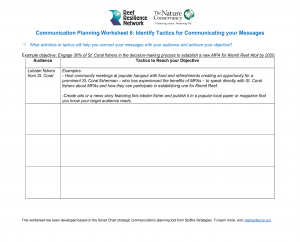Messengers & Tactics
Step 5: Identify Messengers and Tactics for Communicating Your Messages
After identifying the goal, the audience, and key messages, the next step is to identify how you are going to deliver your message to your audience.
Watch a short presentation about identifying messengers and tactics:
Messengers
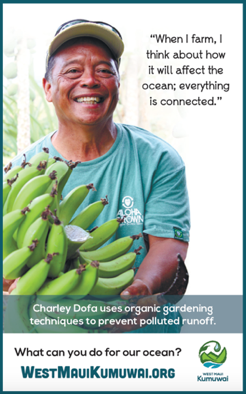
In Maui, Hawai‘i, the West Maui Kumuwai campaign highlighted community members already partaking in the polluted runoff reducing behaviors the campaign wished to promote.
Who delivers your message is just as important as what you choose to say. The right message conveyed by a messenger your audience trusts is likely to be heard; the opposite is also true. To identify an effective messenger, consider who your audience respects or looks up to and who they will listen to. Then find out if you have a connection to this person/people and if they are willing to share your message with your audience. Potential messengers may need encouragement and practice to become comfortable and effective in delivering your message.
Examples of people who can be excellent messengers:
- Community leaders such as church leaders or cultural practitioners
- Friends and family
- Celebrities such as local musicians or radio or TV personalities
- Your staff, partners, colleagues
- Someone already participating in an activity/action you want to promote
- Peers that are in – or will relate to – the target audience
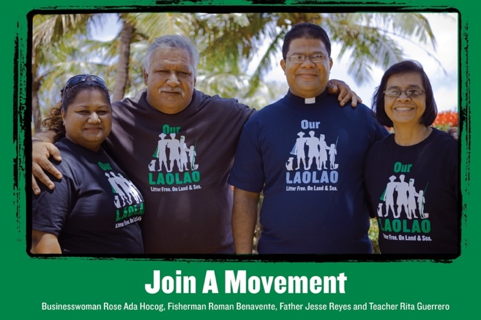
The Our Laolao campaign in the Commonwealth of Northern Marianas Islands engaged respected community leaders who represented different social and culture groups as messengers for its anti-litter platform (click image to enlarge).
COMMUNICATION TIP
Refer back to your Audience Worksheet to determine if any of the influencers listed there might be good messengers.
Your Turn (> 15 minutes recommended)
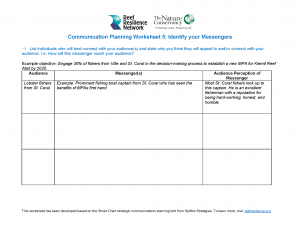 Use the Messenger Worksheet to brainstorm and list individuals you think will best connect with your target audience(s), then write how and in what way these messengers will appeal to and/or connect with them.
Use the Messenger Worksheet to brainstorm and list individuals you think will best connect with your target audience(s), then write how and in what way these messengers will appeal to and/or connect with them.
Guiding questions for selecting messengers:
- Who does your audience trust?
- Who do they look to when forming an opinion?
- Does that person have your target audience’s interest in mind?
- If you’re speaking about a specific place, did they grow up, live, or have a special relationship with the area?
- Does the person have a personal interest, knowledge, and/or experience in the issue, i.e. credibility about the subject?
- Do they bring an authentic tone that people will feel is sincere?
- Will they model the behavior you want to see take place?
- Is it important to have a person with similarities in age, gender, race, etc.?
- Does this messenger have potential risks or controversy that should be considered?
Tactics
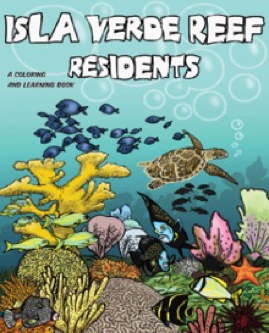
Paco Lopez, graphic design artist and Board Member of Arrecifies Pro Ciudad Inc., Puerto Rico, created an informational coloring book for children to learn about local marine life. He also uses art to help keep pollution off reefs.Learn more.
The best communications efforts use the most direct tactics. Start with learning how your audience gets information and choose a tactic that reaches them as directly as possible. For example, if you’re trying to reach a small group of older fishermen who don’t use the Internet, a social media campaign would not reach them. Instead, a good tactic may be meeting them at the docks after they are done fishing to talk, or placing articles or ads in a local publication they actively read. It is important to select a variety of tactics to engage your target audience multiple times and in multiple places – repetition helps break through the clutter. Typically, the more times a message is heard, the more likely it is to be believed; though it’s also important to make sure you don’t over-share your message and cause message fatigue.
A few other things to consider:
- Does your tactic reach your audience in a way that demonstrates your shared values?
- Does your tactic effectively convey what you want them to do (“the call to action”)?
Brainstorming tactics can be fun! Keep in mind that your budget, staff, and circumstances can affect which tactics you can implement. Consider these questions to assess which tactics are right for you:
- Can you afford it?
- Can you sustain it?
- Will you be able to change tactics if you need to?
Tactics Ideas for Audience Type
The tabs below provide high-level examples of effective communications tactics for various target audiences and tips for successful implementation. This is to give you a taste of the kinds of tactics that may be appropriate for your audience. Tactics can include meetings, formal or informal presentations, a press conference, websites, social media, newsletters, letters, phone calls, paid advertising, community events, field trips, mascots, and more.
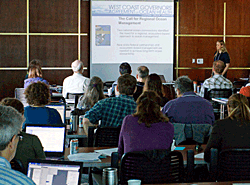
Photo from blog post courtesy West Coast Governors Alliance on Ocean Health.
Examples: Governor, Director of Fisheries Agency
Objective example: By 2010, get the Director of Fisheries to increase the budget for coral reef management by 40%.
Key tactics:
- Face-to-face meetings
- Briefings
- Media engagement
- Constituents as messengers
- Compelling booklet highlighting benefits of increasing budget for reef management
RECOMMENDATION:
- Provide information early
- Present actions and solutions

Photo © Sean Marrs/TNC
Examples: Fisheries cooperative, neighborhood board
Type of objective: By 2018, two fisheries cooperatives are using and promoting the use of a sustainable fishing practice.
Key tactics:
- Meetings
- TV/radio shows
- Newsletters
- Skits or plays
- Community members (peers) and respected leaders as messengers
RECOMMENDATION:
- Choose culturally-appropriate methods
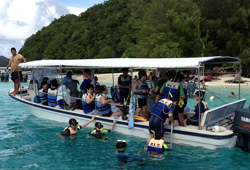
Photo © Sean Marrs/TNC
Examples: Dive shop operators, surfers or tourists
Objective: By 2020, all of the dive shops in the region are implementing sustainable dive practices, like Green Fins.
Key tactics:
- Radio/TV/newspaper
- Internet
- Social media
- Posters
- Meetings
- Participating dive shop acts as messenger for other shops
RECOMMENDATION:
- Decide on the most cost-effective way to reach a large number of people
- Use trade or affinity associations
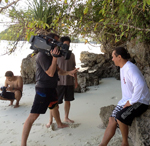
Photo © Sean Marrs/TNC
Examples: Editor at a local paper, radio host
Objective: Before the legislative session starts, editors and staff of all major newspapers understand the value of coral reefs and are prepared to write stories promoting actions to improve reef health.
Key tactics:
- Face-to-face meetings, interviews
- Journalist workshop
- Press releases
- Conferences
- Trips/site visits
RECOMMENDATION:
- Use success stories to inspire positive change
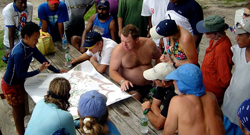
Photo © Stephanie Wear/TNC
Example: Partner organizations
Objective: By 2018, coordinate communication efforts of all partner organizations working to support the expansion of a marine protected area network, and make sure all staff are prepared to share key messages.
Key tactics:
- Telephone
- Websites
- Presentations
- Print materials such as a fact sheet or brochure
RECOMMENDATION:
- Use the Message Box to collaboratively develop shared messages for consistency
Idea Bank
Skim the Idea Bank for some inspiration or check out NOAA's Communicating for Success booklet for guidance on media, events, exhibits, videos, podcasts, list serves, online communication, and print materials, including brochures, fact sheets, and posters. The Idea Bank below was developed collaboratively with ![]() .
.
Get attention through guerilla marketing, a communications tactic that uses fast, creative methods, often combined with a sense of humor, to get an audience’s attention and move them to action quickly. Examples include art installations in public places, stencils on sidewalks, and flash mobs, like the one the 4FJ campaign organized to raise awareness about declines in fish populations and ask onlookers not to eat grouper during spawning months.
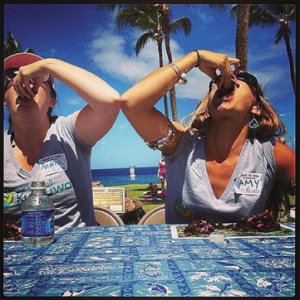
Photo © West Maui Kumuwai
Another example from Maui, Hawai‘i is a seaweed-eating contest the West Maui Kumuwai campaign organized to draw attention to the role parrotfish, and other algae-eating animals, play to keep corals healthy. The event drew a new audience into the discussion and landed the campaign on the front page of the local newspaper.
Tell a story like Kathy Jetnil-Kijiner, a talented young poet from the Marshall Islands, did when she wrote and performed the expressive poem “Dear Matafele Peinem". Jetnil-Kijiner’s poem about climate change and the threat it poses for many low-lying Pacific Island nations was performed at the United Nations Climate Summit to capture the attention of international media and build support for climate change mitigation policy. See how it was picked up by media.
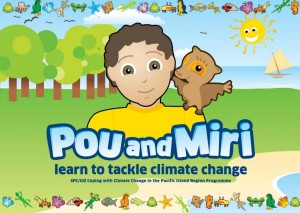
Example from Secretariat of the Pacific Community, 2011. Story and Illustrations by Dom Sansom.
Instruct through storybooks and coloring books which capture children’s attention and serve as prompts, reminding them (and their parents) of the target behaviors. Stories can help simplify complex ideas and make concepts such as climate change relevant and important. For example, The Pou and Miri series of storybooks were designed by the Secretariat of the Pacific Community (SPC) and the German Overseas Development Agency (GIZ) to help children understand climate change causes, impacts and solutions. These books reinforce behavioral changes by linking the abstract concept of climate change to real, tangible everyday actions. The books also act as prompts or reminders for behavior adoption. Reaching children at an influential life stage through interactive media, increases the likelihood that they will remember concepts and messages long after your campaign has ended.
Resource: Storytelling as Best Practice, Andy Goodman
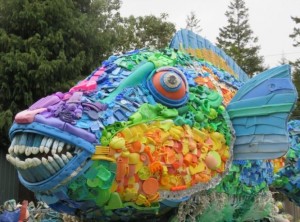
Photo © WashedAshore.org
You can use art to educate people about your issue and solution. This should be in a visible, public space in order to normalize the desired behavior and remind people to adopt it. Best yet, get the community to help create it! Example: Priscilla the Parrot Fish is a 16-foot-long sculpture made entirely of marine debris by the conservation organization Washed Ashore. Priscilla went on display at a Sea World park in order to raise awareness of the problem of marine pollution. Sharing messages and influencing behavior through visible reminders can be even more helpful when incorporated into regularly used items, such as notepads, pens, fridge magnets, light switch covers, buckets, etc.
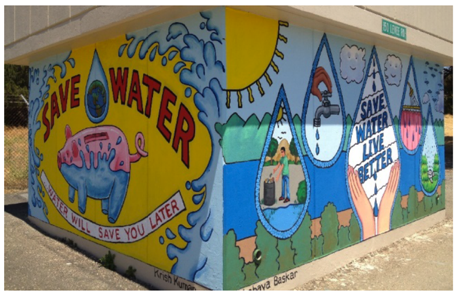
Murals painted in public places, like this one on a park water tank (water conservation initiative), can motivate, inspire, or remind people to take a specific action. Photo © Margaret Thornberry
For example, a calendar, created by the Palau International Coral Reef Center, is a continual reminder for people in Palau of the important role of herbivorous fish on reefs. 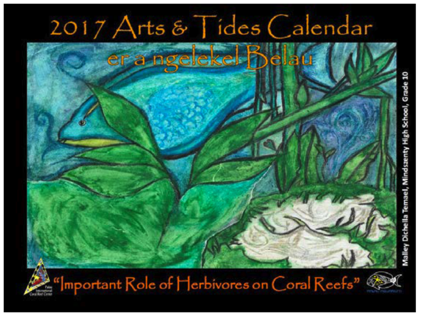
Another example is this children's coloring sheet that has important information about a community's work to manage their fishery.
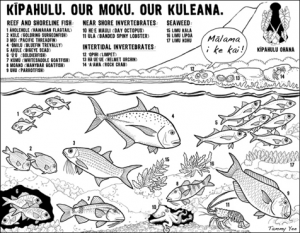
Coloring activity designed by Kīpahulu Ohana, a community group working to revive traditional practices and manage marine resources in Maui, Hawaii.
Resources to help you coordinate a community mural: Community mural: A facilitator’s guide to mobilizing community environmental action, How to create a community mural
Create a catchy song to draw awareness to your issue. For example, Bahamas’ “Conch Gone” song has raised national awareness about the decline in the country’s conch populations as part of the Conchservation campaign. The campaign asks Bahamians to make sure conch are a certain size before catching in order to ensure there are conch in the future.
The Coral Song created by A.J. Jenkins, video by KidsTV123, is a fun song for kid’s about coral reefs, why they are important, and what actions kids should take to help keep them healthy.
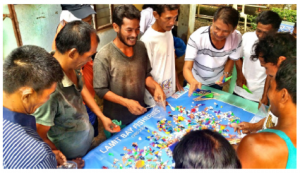
Participants in Palau play "What's the Catch" to learn about fisheries management. Photo © Rare
Engage stakeholders – such as fishers, government officials, and youth – in discussions and demonstrations about your topic/project by making learning hands-on and interactive. This can include playing games, enlisting them as citizen scientists, or hosting field trips so they can “see for themselves." For example, “What’s the Catch?” is an interactive game that allows players to experience the ups and downs of fishing and fisheries management. By managing the fan-tailed goldfish fishery, players learn first-hand the failures of conventional fisheries management and the benefits of catch share management. This is a great tool to facilitate discussion in communities that are interested in improving fisheries management.
Stakeholders can be directly engaged in collecting information to inform management decisions. For example, you can involve your community in observing, measuring, and analyzing changes in the beach environment. This is a great way to directly engage people on the issue of climate change, help them see changes for themselves, and empower them to take action.

Climate Change Adaptation Tools Training participants learn how to profile a beach in the Seychelles. Photo © TNC
Another example of citizen science is Hui O Ka Wai Ola, a group of volunteers who measure and share the status of Maui's water quality. The Nature Conservancy scientists, along with other partners, train volunteers on scientific monitoring protocols. The information they compile helps the State of Hawai‘i fill critical data gaps and develop management strategies.

Citizen scientists collecting water samples in Maui, Hawaii. Photo © Dana Reed
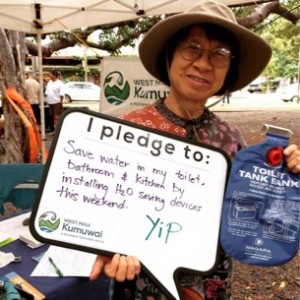
West Maui Kumuwai pledge participant. Photo © West Maui Kumuwai
Ask people to pledge their support and publicly commit to action as a way to inspire others and help with follow-through (individuals who make a public commitment are far more likely to adopt change). For example, through the West Maui Kumuwai campaign, Maui residents pledge to take action to stop polluted runoff from reaching the ocean. Pledgers decide what action they will commit to, fill out the pledge board, and pose for a photo which is displayed on the campaign's website. This public display of commitment makes it far more likely that individuals will engage in the desired action.
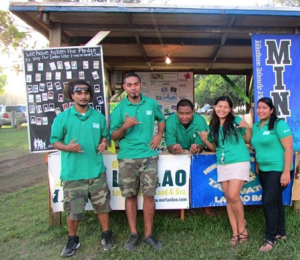
Our Laolao anti-litter pledge display board at a community event. Photo © Our Laolao
Similarly, individuals in Saipan, CNMI, pledge to not litter as part of the Our Laolao Anti-Litter campaign. Pledge photos are added to a display board and showcased during community events.
Another great way to showcase community support for an action is through public art, such as a mosaic of individually painted tiles with commitments, a public mural with sea creatures made from handprints that represent a pledge, or perhaps driftwood fish swimming around a save the reef slogan.
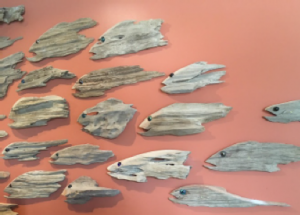
"Commitment fish" is part of an art installation showcasing positive actions people are taking for reefs.
These attractive displays can be a great tool for capturing personal commitments and making them visible beyond the life of your campaign. Consider a permanent (or semi-permanent) space where people can pledge to adopt reef-friendly actions.
Test Your Understanding
Test your understanding of the information in this section by taking the quiz.
Your Turn (> 25 minutes recommended)
Use the Tactics Worksheet to brainstorm and list tactics you think will best reach your target audience(s). Leave the second column on this worksheet blank for the next measures activity. Have fun thinking about tactics, but remember your objective and where/how your target audience gets information. Start with the easy stuff and get your ideas down on paper. Brainstorm what you and your audience have access to. Don’t be afraid to think outside the box and get creative!
Guiding questions for selecting tactics:
- Are the tactics you listed within your organization's capacity?
- Will your tactics reach your audience?
- How do people in your target audience communicate with one another?
- Does your audience read news or watch TV news or get their news via social media? Which channels?
- Who does your audience trust?
- Is this communications tool/tactic appropriate for your topic, issue, and message? Is it culturally sensitive and does it demonstrate your shared values?
- Does your timing consider key dates and events? Is there any event or holiday/anniversary coming up that you could build a tactic around?
- Are you being realistic about what you can accomplish given the people and dollars available to support your effort?
- Is there a way to measure how effective each tactic is? Write down the kinds of measures you will use to assess your tactics. If you can’t measure a tactic, make note of this.
This worksheet is based on Spitfire Strategies’ Smart Chart® strategic communications planning tool. The Smart Chart is a registered trademark of Spitfire Strategies. To learn more, visit: spitfirestrategies.com.

